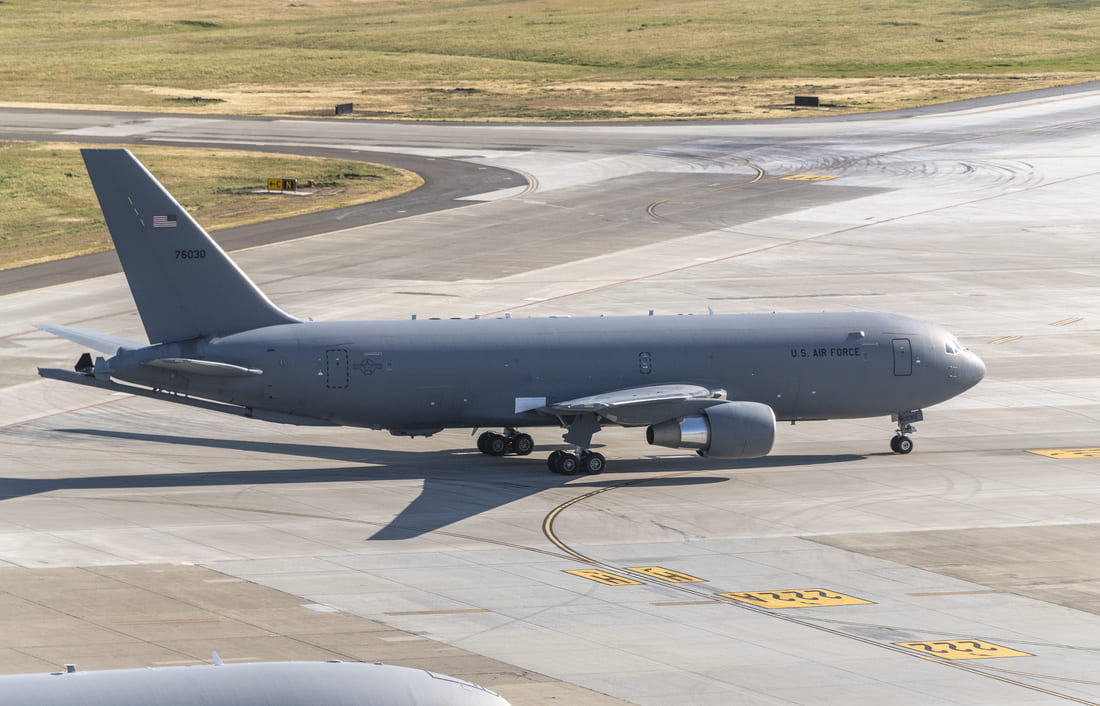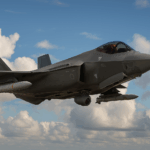JERUSALEM – Israel’s Defense Ministry moved this week to strengthen two core elements at once. Aerial refueling for long-range missions, and the armored force used in urban combat. It instructed its U.S. mission to finalize a Foreign Military Sales case for two additional KC-46A Pegasus tankers worth about $500 million, pending approval by the ministerial committee for defense procurement. In a separate step, the ministry advanced a five-year Armored Vehicle Acceleration Project worth NIS 5 billion (≈$1.5 billion) to deliver dozens of Merkava IV Barak tanks along with Namer and Eitan armored personnel carriers. The plan also funds factory upgrades across Israel.
Maj. Gen. (res.) Amir Baram, the ministry’s director general, said the fifth and sixth KC-46As will reinforce the long-range strike arm and extend reach into distant theaters with greater weight of effort. The ministry said the aircraft will carry Israeli subsystems tailored to the air force needs. The tanker decision came after a June air campaign against Iran that demanded long ranges and high sortie rates. Israel’s legacy Boeing 707 tankers, converted locally decades ago, carried much of that load.
Two KC-46A airframes for Israel – funding source, fitted systems and ministerial sign-off
The tanker package sits within the U.S. foreign military sales framework. Funding will come from the annual American security assistance tranche, and the contract will be signed with the U.S. government once Israel’s ministerial committee clears it. The ministry’s statement pegs the scope at “approximately half a billion” dollars.
The aircraft will integrate unspecified Israeli systems – likely in communications and mission support – installed to national standards. Israel holds prior approvals for up to eight KC-46As. Four airframes are already under contract, and the add-on pair takes the planned fleet to six. Delivery of the initial batch has not finished. Local reporting and officials point to 2026 as the window for the first aircraft to enter service after U.S. and Israeli configuration work finishes.
The push for two more tankers aims to close the gap between demand and available booms after a period of intensive long-range operations. Officials involved in the planning describe a straightforward operational need. The KC-46A carries roughly 207,000 pounds of fuel and can service a wide mix of fighters and transports through boom and drogue kits. It also provides cargo and medevac capacity, which reduces the number of tails needed to stage a strike package.
Israel’s 707 Re’em fleet still flies refueling and command-and-control sorties, yet age and availability drive risk. The KC-46A’s remote vision system and defensive suite, together with national communications fits, target higher availability and safer contact at night and in marginal weather. According to industry sources, aircrew training and certification pipelines are already mapped to align with the delivery sequence so the new tankers do not sit idle on the ramp.
The ministry timed the KC-46A action alongside ground-force recapitalization steps rather than split them into different budget cycles. The choice links strategic range with staying power on land, and it pushes procurement governance through the same committee cadence. As a result, both the tanker case and the armored vehicle program face the same near-term gate: formal sign-off by Israel’s defense procurement ministerial committee.
KC-46A tranche:
- Quantity: 2 aircraft (fifth and sixth for Israel) under a U.S. FMS case.
- Value and funding: ≈$500 million, financed from U.S. aid.
- Integration: Israeli mission systems tailored to IAF use.
- Status: contract to be signed after ministerial approval; earlier four remain in the pipeline with first service entry expected around 2026.
Five-year NIS 5bn push to speed Merkava, Namer and Eitan production – delivery targets and configurations
The ministry advanced a plan worth over NIS 5 billion to enlarge and speed production of core armored platforms. The package covers additional Merkava IV Barak main battle tanks, heavy tracked Namer APCs and the wheeled 8×8 Eitan APC, some configured with turreted 30 mm cannons. The plan cites recent combat lessons and calls for “dozens” of added vehicles over five years. The Merkava and Armored Vehicles Directorate (MANTAK) will lead in coordination with the Defense Procurement Directorate, IDF Ground Forces and the Technological and Logistics Directorate.
Defense Minister Israel Katz described the step as a strategic move to keep maneuver brigades supplied with protected mobility and firepower while stabilizing order books for suppliers scattered nationwide. The ministry framed the plan as a blend of near-term output and long-term industrial resilience. Plant expansions, workforce growth and depot upgrades appear as explicit budget lines to avoid production bottlenecks. The Eitan 8×8 will keep rolling off the line in a combat-ready configuration rather than an austere baseline to be up-gunned later.
Urban fighting drove high usage hours for armor, which exposed maintenance strains and spares gaps. The accelerated schedule aims to deliver platforms and parts flow in the same window, not only fresh hulls. Officials highlighted the Barak variant’s digital architecture and active protection as the baseline for future batches, not an optional upgrade path. The decision sets a single fleet standard across new tanks and simplifies training and sustainment.
Throughput will expand at existing Israeli sites rather than on a greenfield line. MANTAK and prime contractors will spread sub-assemblies across current plants to reduce risk if any one site slows or halts. The dispersion also channels work to peripheral regions where many armor vendors operate. The ministry linked the approach to a broader “defense-industrial base resilience” effort that predated this week’s announcements but now has a dedicated funding stream.
Factory upgrades, supplier payments and the Knesset timetable that will unlock deliveries
The defense procurement ministerial committee’s endorsement moves the armored-vehicle project to the Knesset’s Joint Committee on the Defense Budget – a forum that combines finance and foreign affairs and defense oversight. Once the joint committee approves the line items, the ministry can sign agreements with dozens of firms, including second- and third-tier suppliers. Defense officials say the contracting wave will cover training devices, long-lead materials, depot tooling, and spares packages, not only vehicle hulls.
The ministry calendars place this decision at the front of a wider mobilization period. The IDF is calling up a large tranche of reservists as heavy units rotate through Gaza-area missions and other fronts. In that setting, armored availability and readiness rates carry budget weight – vehicles must arrive with the right kits and with mechanics trained before they reach battalion motor pools. The outline points to deliveries spread across five years, with early focus on lines that can surge without retooling and with depot capacity rising in parallel.
The plan addresses uneven cash flow to small and mid-sized shops. The ministry will structure milestone payments around sub-assembly completions to smooth cash cycles below the prime level so suppliers can retain staff and hold inventory through surge months. The practice proved useful during high-tempo periods when frontline units cannibalized parts and depots ran short on stock. Our analysis shows moving cash earlier to tier-2 and tier-3 reduces delivery risk more than any single tooling purchase at a prime’s main plant, because Israeli armored vehicles rely on wide vendor networks tied to electrical harnesses, optics, armor modules and data buses.
Thousands of XTEND FPV drones for ground forces
The ministry paired heavy armor buys with small drones. A multi-million-dollar tender to XTEND covers thousands of first-person-view systems for ground units, bundled with training and control gear. Deliveries will start in the coming months. The package scales a capability already used in small numbers by IDF battalions and formalizes a pipeline for replacements and attrition.
Open figures vary by model and lot, but public disclosures point to a batch on the order of several thousand units with options for more. Company statements describe 10-inch class airframes with a payload around 2.5 kg, fit for single-use attack or precision drop depending on the kit. The XR-series control scheme pairs with VR goggles that cue the operator’s view and smooth steering during high-speed turns. The ministry treats these as consumables. Field companies will issue them at squad or platoon level and expect sustained losses in dense urban fights.
XTEND will run the training track. The contract includes instruction packages that bring conscripts and reservists into a common syllabus, not a patchwork of unit-level hacks. The intent is to cut the time between arrival at a brigade staging area and first combat sortie, and to collect user data for incremental tweaks to airframes and software. It keeps FPV use inside the army’s standard deconfliction rules so ground commanders can choreograph drone runs with tank gunnery, infantry movement, and air-delivered fires.
The small-drone surge complements the armored plan rather than competes with it. Armor pushes and holds ground through shock and protected lift. FPV drones pull reconnaissance forward and strike point targets that would expose crews. The ministry chose to resource both at once to close kill chains at short range as well as long. The tanker buy follows the same logic. Strike packages need reliable gas to reach distant launch points and return, and ground units need survivable carriers and cheap airborne tools to punch through dense blocks.
Amir Baram’s tanker line and Israel Katz’s armor announcement landed within days of each other. The air force gains endurance, the army gains mass and protection, and the industrial base gains funded upgrades and longer order books. Defense officials confirm the ministry will push both files through the Knesset budget gate together if the calendar allows, although each can move on its own track if committee timing splits in September.
Ido Nehushtan, a former air force commander who now heads Boeing’s Israel office, framed the KC-46A addition as a natural step in a decades-long aerospace relationship. The aircraft joins a logistics system used across U.S. and allied fleets, which simplifies common training and simulator access when schedules align.
The ministry’s focus on domestic manufacture for ground systems, and a U.S.-funded import for tankers, reflects practical constraints not ideology. Israel does not run a widebody airliner final-assembly line, so it buys the airframe abroad and tailors the mission package at home where needed. In armor, domestic factories and depots already exist, so public money buys faster throughput and a deeper spares stack.
The June 2025 twelve-day exchange with Iran forced round-trip flights on the order of 2,000 miles for strike and escort jets. Yemen raids demanded more tanker coverage for platforms loitering over air-defense threats. On land, battalions in Gaza ran tempo that burned through tracks, engines, and armor modules. After months of wear, planners chose to buy speed where it counts: gas in the air, steel on the ground, and disposable eyes with standoff charges in the hands of squads.
KC-46A deliveries must mesh with crew training and with fixes to the type’s U.S.-service issues, including remote vision refinements scheduled across the production run. The armored surge depends on stable sub-supplier output for optics and electronics with long lead times. The drone push will meet a learning curve in unit-level employment and logistics. The sequence funds missions that carry the most weight now and adds industrial resilience for shocks that stretch beyond planning assumptions.
REFERENCE SOURCES
- https://theweek.com/world-news/israel-defense-forces-manpower-problem
- https://www.reuters.com/business/aerospace-defense/israel-place-500-million-us-funded-order-boeing-aerial-refuelling-tankers-2025-08-20/
- https://www.timesofisrael.com/liveblog_entry/israel-to-purchase-2-more-american-kc-46-refueling-planes-for-its-air-force/
- https://www.janes.com/osint-insights/defence-news/land/israel-ramps-up-tank-apc-production
- https://www.overtdefense.com/2025/08/25/israel-approves-1-5-billion-plan-to-boost-armored-vehicle-production/
- https://euro-sd.com/2025/08/major-news/45958/idf-afv-production-speed-up/
- https://www.jns.org/israel-advances-1-5-billion-plan-to-up-local-production-of-armored-vehicles/
- https://www.twz.com/air/israel-wants-more-kc-46-pegasus-tankers-to-boost-overworked-aerial-refueling-fleet
- https://thedefensepost.com/2025/08/25/israeli-forces-drones-xtend/
- https://thedefensepost.com/2025/08/26/israel-boeing-kc-46-tankers/



